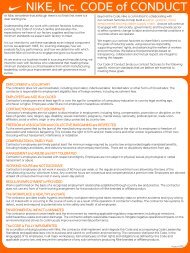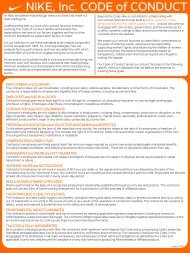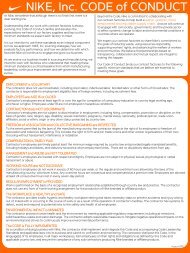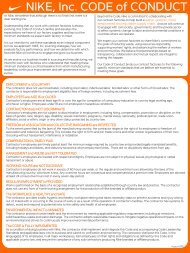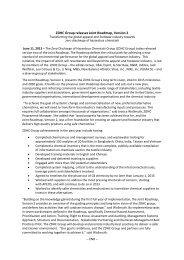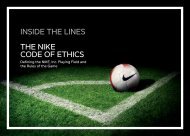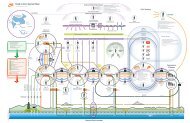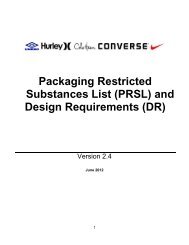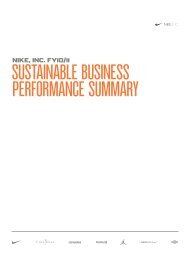COC CLS - Healthy Safety Environment - NIKE, Inc. - The Journey
COC CLS - Healthy Safety Environment - NIKE, Inc. - The Journey
COC CLS - Healthy Safety Environment - NIKE, Inc. - The Journey
You also want an ePaper? Increase the reach of your titles
YUMPU automatically turns print PDFs into web optimized ePapers that Google loves.
NANOMATERIAL MANAGEMENT<br />
• Work areas should be cleaned at the end of each work shift (at a minimum) using either<br />
a HEPA-filtered vacuum cleaner or wet wiping methods. Dry sweeping or air hoses should<br />
not be used to clean work areas. Cleanup should be conducted in a manner that<br />
prevents worker contact with wastes.<br />
• <strong>The</strong> storage and consumption of food or beverages in workplaces should be prevented<br />
where nanomaterials are handled.<br />
• Hand-washing facilities should be provided and workers encouraged using them before<br />
eating, smoking, or leaving the worksite.<br />
• Facilities for showering and changing clothes should be provided to prevent the<br />
inadvertent contamination of other areas (including take-home) caused by the transfer<br />
of nanoparticles on clothing and skin.<br />
• Evaluation and selection of appropriate personal protective equipment (PPE) to<br />
correspond with existing conditions in the workplace inclusive of nanoparticle resistant<br />
gloves and respiratory protection with a NIOSH approved protection factor of not less<br />
than 10.<br />
• <strong>The</strong> systematic evaluation of exposures to ensure that control measures are working<br />
properly and that workers are being provided the appropriate personal protective<br />
equipment.<br />
c. Waste management:<br />
• Cleaning up nanoparticle powder and liquid spills must include the use of HEPA-filtered<br />
vacuum cleaners, wetting powders down, using dampened cloths to wipe up powders<br />
and applying absorbent materials/liquid traps.<br />
• Damp cleaning methods with soaps or cleaning oils is preferred. Cleaning cloths should<br />
be properly disposed. Drying and reuse of contaminated cloths can result in re-dispersion<br />
of particles. Use of commercially available wet or electrostatic micro fiber cleaning<br />
cloths may also be effective in removing particles from surfaces with minimal dispersion<br />
into the air.<br />
• Energetic cleaning methods such as dry sweeping or the use of compressed air should<br />
be avoided or only be used with precautions that assure that particles suspended by the<br />
cleaning action are trapped by HEPA filters. If vacuum cleaning is employed, care<br />
should be taken that HEPA filters are installed properly and bags and filters changed<br />
according to manufacturer’s recommendations.<br />
• Handling and disposal of the waste material should following existing local laws and<br />
adherence to Nike Hazardous & Solid Waste Code Leadership Standards.<br />
3. TRAINING—<br />
PPE: Training will be conducted at the time of initial assignment and at least annually thereafter.<br />
Training must cover as a minimum:<br />
• What and when PPE is required and limitations of PPE.<br />
<strong>Safety</strong> <strong>CLS</strong> – Page 3<br />
04.14.10



